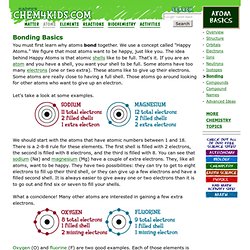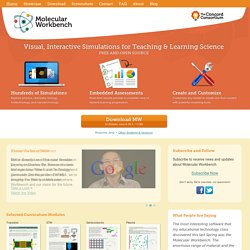

Energy Kids - For Teachers. CanvasMol. DNA Interactive: Discovering the DNA Structure and beyond. Periodic Table of Elements and Chemistry. Electromagnetic Spectrum: Radio Waves. Global rating average: 0.0 out of 50.00.00.00.00.0 These sites explain how radio waves are a part of the electromagnetic spectrum.

Includes information about AM and FM frequencies and how to measure waves. Also includes a biography on Marconi, inventor of the radio. Includes several animated movies, hands-on activities and interactive quizzes. There is a link to an eThemes Resource on sound. Grades Links The Electromagnetic Spectrum This site provides a good overview of waves and electromagnetic waves. Education Standards Request State Standards. Electricity: Circuits, Conductors, and Batteries. Global rating average: 0.0 out of 50.00.00.00.00.0 These sites have lots of illustrations and animations that demonstrate how electricity, circuits, and batteries work.

Learn the difference between conductors and insulators and the difference between series circuits and parallel circuits. Includes a lesson plan, suggested activities, hands-on experiments, and online games and quizzes. There are links to eThemes resources on electrical safety, current and static electricity. Grades Links PBS: AC/DC: What's the Difference This animated feature demonstrates the difference between alternating and direct currents. Education Standards Request State Standards. Strange Matter: Stuff for Teachers. Download a Teacher's Guide Our teacher's guide is focused for grades 5 to 8.

It includes background on the exhibition, pre- and post-visit hands-on activities using inexpensive, easy-to-find materials, teaching strategies, a glossary, resource lists and more. Download the Guide (At 1.4 MB, the guide will take about 4 minutes to download on a 56KB modem. If you don’t already have a copy, you’ll need the free Acrobat Reader to view and print the guide.) Explore in class - online Can't visit the exhibition or just want to get started right away? Your class can investigate materials by exploring four critical aspects of Materials Science: Experience the structure of materials in Zoom. ...or if you've got something specific in mind, jump straight to your favorite stuff.
Featured Demonstration. Untitled Document. Atoms: Bonding. You must first learn why atoms bond together.

We use a concept called "Happy Atoms. " We figure that most atoms want to be happy, just like you. The idea behind Happy Atoms is that atomic shells like to be full. That's it. If you are an atom and you have a shell, you want your shell to be full. Let's take a look at some examples. We should start with the atoms that have atomic numbers between 1 and 18. What a coincidence! Oxygen (O) and fluorine (F) are two good examples. So, let’s say we've got a sodium atom that has an extra electron. When they work together, they can both wind up happy! Molecular Workbench - An Interface to the Molecular World. Three Views of MW Senior Scientist and Molecular Workbench Developer Charles Xie, Researcher and Manager Amy Pallant, and Technology and Curriculum Developer Dan Damelin describe the history of Molecular Workbench and our vision for the future.

Watch the Video undefinedundefinedundefined Selected Curriculum Modules Transistor Semiconductor Plasma Molecular Rover Chemical Bonding. Dynamic Periodic Table. Global Carbon Footprints. About this graphic Graphics by Stephen Rountree and Adam Marr Source: World Resources Institute CAIT 2.0 climate data explorer Emissions data and national boundaries are from 2010.

For current emissions, per capita emissions, and intensity, the data are measured in tons of "carbon dioxide equivalent. " That is, they include carbon dioxide and five other greenhouse gases (methane, nitrous oxides, hydrofluorocarbons, perfluorocarbons, and sulfur hexafluoride) as measured by their global warming potential. Cumulative emissions are measured in tons of carbon dioxide only. The emissions of Brazil and Indonesia may be understated because the numbers do not include calculations on land use change and forestry. There are high uncertainties in current measures of deforestation's contribution to greenhouse gas emissions, as international authorities work to develop a consistent methodology.